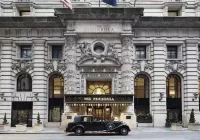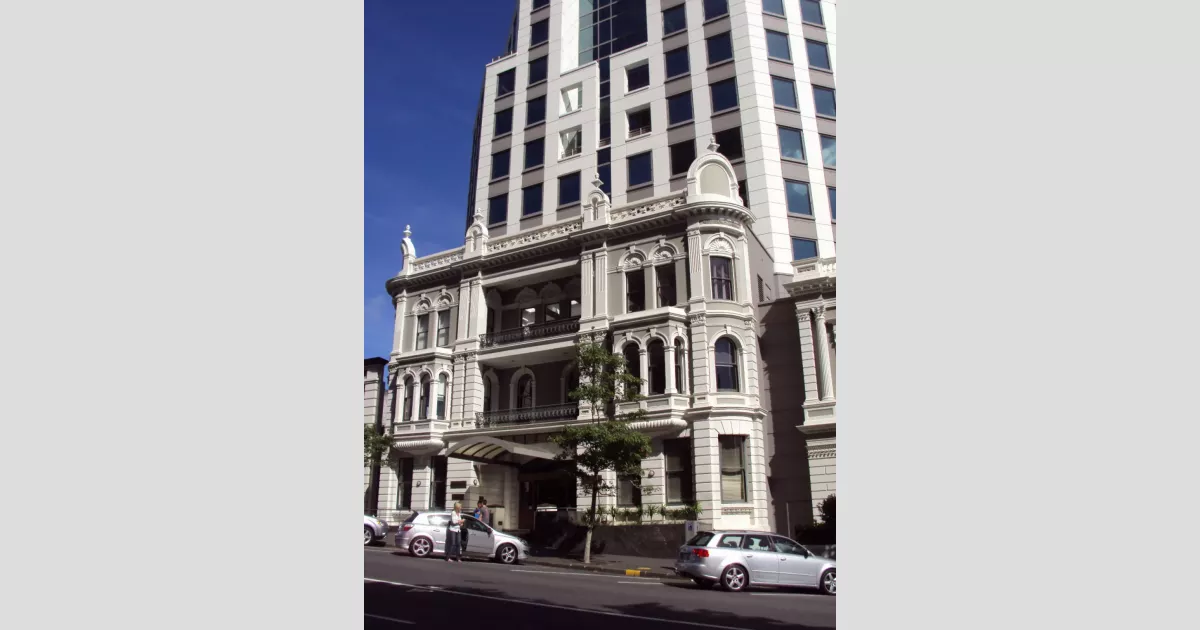The Grand Hotel, situated at 9 Princes Street, held the title of Auckland, New Zealand's premier hotel from its establishment in 1889 until 1966. Its opulent design, featuring vaulted ceilings, ornate mantelpieces, and luxurious red carpets, made it a sought-after social hub. Although the hotel was later repurposed into office spaces in 1967-1968 and renamed the 'Grand Building,' its facade remains a significant landmark. It stands as the last surviving example of the grand Victorian and Edwardian-era hotels that once graced Auckland's streetscape.
1900: Expansion on Bankside Street
In 1900, the Grand Hotel underwent an expansion project on Bankside Street, adding to its footprint and potentially accommodating more guests or facilities.
1902: Rebuilding after the Fire
A significant fire in 1901 forced the Grand Hotel to undergo a major rebuilding project in 1902. While the fire caused significant damage, the front and side facades of the hotel survived and were incorporated into the rebuilt structure.
1902: E.M. Waite's Painting Exhibited
In 1902, a painting by artist E.M. Waite titled "Reposing in decay serene (Lounge of Grand Hotel)" was exhibited at the Royal Academy. This oil painting, depicting the hotel's lounge, provides a glimpse into the hotel's interior during that era.
1913: Final Major Expansion
The Grand Hotel underwent its last major expansion in 1913, adding a new dining room, an updated kitchen, a scullery, and an open-cage lift. This expansion likely aimed to modernize the hotel's amenities and enhance the guest experience.
1937: Lesley Horace Rose Becomes Head Chef
In 1937, Lesley Horace Rose assumed the role of Head Chef at the Grand Hotel, a position he would hold for nearly three decades, becoming an integral part of the hotel's legacy.
May 1966: The Grand Hotel's Victorian Charm
In May 1966, the New Zealand Herald published an article highlighting the Grand Hotel's enduring Victorian charm, with its ornate facade, wrought iron balconies, and plush interiors. The hotel's manager at the time, Mr. S.T. Johnson, shared his fondness for the hotel's old-world ambiance, which even impressed notable guests like Lord Denning.
December 1966: The Final Days and Auction
Following the closure, the Grand Hotel's bar, a hub of social life for many years, closed its doors "quietly and sedately." On December 14, 1966, a grand auction was held at the hotel, selling off its remaining contents, including paintings, chandeliers, mirrors, chairs, and other fittings. Private collectors and dealers also acquired furniture and artifacts, marking the dispersal of the hotel's historical furnishings.
December 1966: Auction of the Grand Hotel's Art Collection
On December 14, 1966, as part of the Grand Hotel's closure, the hotel's impressive art collection, amassed by Moss Davis and Ernest Hyam Davis, was auctioned off. The collection included numerous valuable paintings, many of which had originated from the United Kingdom and returned there after the auction.
1966: Closure of the Grand Hotel
After 77 years of service, the Grand Hotel in Auckland closed its doors in 1966, marking the end of an era for this iconic establishment.
1966: Staff Farewell and Chef Rose's Reflections
As the Grand Hotel prepared to close in 1966, a poignant farewell party was held for the staff in the hotel's dining room. Head Chef Lesley Horace Rose, who had served at the hotel since 1937, expressed his sadness at the closure, viewing it as the end of an era for traditional hotels. He remarked on the remarkable loyalty of the staff, many of whom remained until the final days despite knowing the hotel's fate.
1966: Tene Waitere's Fireplace Mantel Removed
When the Grand Hotel closed in 1966, the remarkable 3-meter x 1.9-meter fireplace surround and mirror overmantle, a masterpiece carved by renowned Maori artist Tene Waitere in 1887, was removed from the hotel's lounge. The mantel has since been in private ownership.
1967: Reopening as the Grand Building
A year after its closure as a hotel, the Grand Hotel building reopened in 1967 as the 'Grand Building', repurposed to house offices.
1972: Closure of the Central Hotel
The Central Hotel, another prominent hotel in Auckland, closed its doors in 1972, following in the footsteps of the Grand Hotel.
1979: Controversial Heritage Protection Reduction
In a controversial move in 1979, the Auckland City Council downgraded the heritage protection status of the Grand Hotel building. While initially fully protected, the new designation only covered the building's front facade, leaving the rest of the structure vulnerable to potential demolition or significant alteration.
1987: Approval for Office Tower Development
In 1987, the Auckland City Council approved a development project to construct a 15-floor office tower on the site of the Grand Hotel. The project planned to incorporate the facades of both the Grand Hotel and the adjacent 1881 Freemasons Hall into the new structure.
1988: Demolition and Facade Incorporation
Demolition of the Grand Hotel, apart from its facade, began in 1988. The retained facade was incorporated into the new glass office tower, which would eventually become the headquarters of the dairy company Fonterra.
2016: Facade Preservation and Apartment Conversion
In 2016, a new project was announced to preserve the facades of the Grand Hotel and Freemasons Hall, which were now part of the Fonterra office tower. The project aimed to convert the office space behind the facades into apartments called 'The International.' Architects Jasmax and Marchese Partners led the redesign, while Bonacci Group (now Meinhardt-Bonacci) oversaw structural strengthening and redesign. Dominion Constructors took over as the main contractor after Fletcher Building withdrew. The project has since been completed.
Mentioned in this timeline
New Zealand is an island country located in the southwestern...

Fire is a rapid oxidation process called combustion releasing heat...

A star is a self-gravitating luminous plasma spheroid The Sun...

A hotel is a commercial establishment offering short-term paid lodging...

The title Duke denotes a male monarch ruling a duchy...
Trending
7 minutes ago Newly Built Chinese Bridge Collapses Months After Opening, Raising Safety Concerns
8 minutes ago Yen's Record Low Sparks Intervention Debate Amidst Japan's Cautious Rate Hike Approach.
8 minutes ago Canada-China relations deepen amid Trump's trade war; cooperation and exchanges are set to increase.
Skyline High School is a public secondary school located in Oakland California and operates as part of the Oakland Unified...

4 months ago Dave Franco and Alison Brie's 'Together' Releases Creepy Photo Album and Trailer

5 months ago Jean Smart and John Krasinski Shine in Separate Broadway Shows Amidst Gender Discussions.
Popular

Nancy Pelosi is a prominent American politician notably serving as...

Chuck Schumer is the senior United States Senator from New...

Bernie Sanders is a prominent American politician currently serving as...
Nicholas J Fuentes is a far-right political commentator and activist...

Zohran Kwame Mamdani is an American politician currently serving as...

William Franklin Graham III commonly known as Franklin Graham is...
